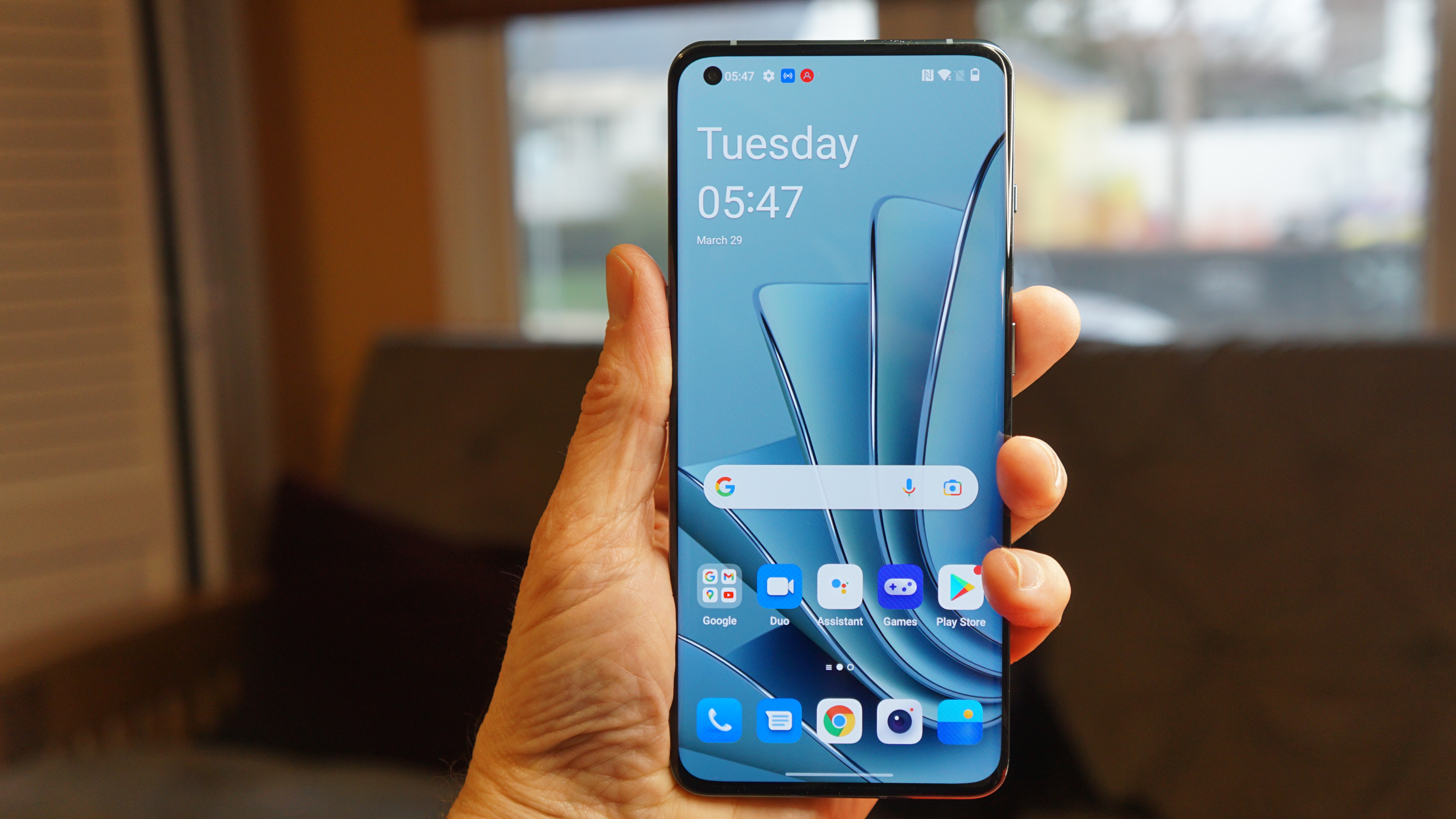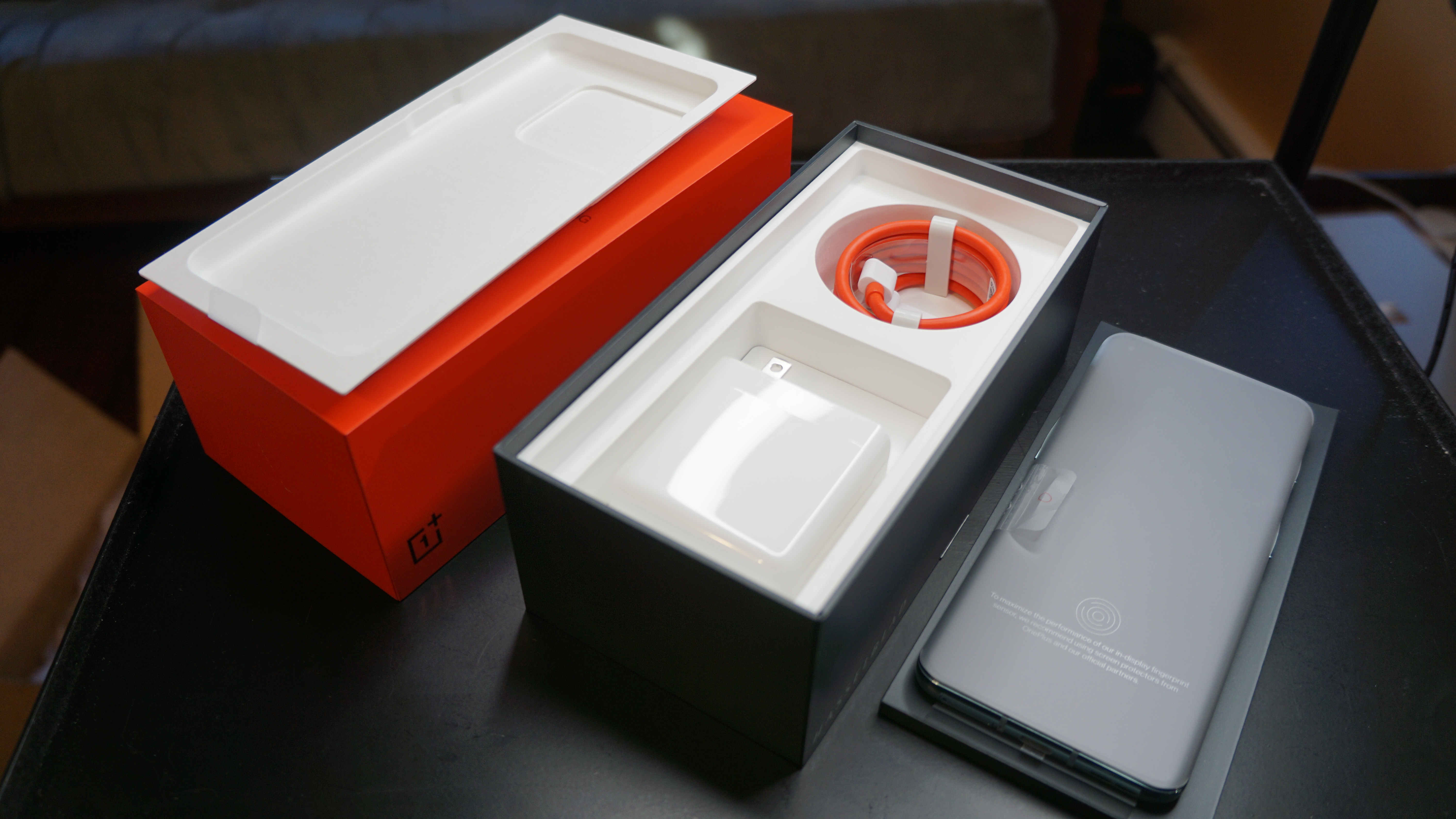Two-minute review
OnePlus phones were once referred to as ‘flagship killers’, but over time the company deserted its mid-range roots to create the flagship phones it previously sought to beat.
The OnePlus 10 Pro doesn’t herald a return to the company’s mid-range hey-day, but a spark of that slogan is definitely still burning somewhere in the company because compared to the myriad premium phones we’ve seen in early 2022, this handset feels like smart counter-programming.
We say that because the OnePlus 10 Pro is cheap. Not ‘budget phone’ cheap - you’re not going to be seeing this on store shelves in the same section as Nokia or Redmi phones - but cheap compared to other Pro and Plus phones, with a price tag that may well sway you from rivals.
Launched in December 2021 in China, and then globally in March 2022, the OnePlus 10 Pro was released within months of the Samsung Galaxy S22 Plus, Xiaomi 12 Pro, and Oppo Find X5 Pro. It undercuts all those phones, in a few cases by quite a margin, despite having specs that easily go toe-to-toe with them.
The closest comparison is definitely that Oppo flagship, as the fruits of OnePlus’ merger with Oppo has resulted in two very similar phones. They have almost identical software, the same Hasselblad camera modes, and similar-looking displays - however, the OnePlus is quite a bit cheaper.
So if you’re looking for a top-end mobile, this is the most affordable option - though it’s a shame that no ‘standard’ OnePlus 10 is coming.
This is an impressive phone - perhaps our favorite aspect is the display, as the phone’s 6.7-inch 2K screen looks great for streaming TV shows, playing games or swiping through your social media app of choice.

That’s a big screen size, and people with small hands might find the corners of the display hard to reach - but the trade-off is more pixels with which to enjoy content.
It’s a powerful phone, too, thanks to packing the Snapdragon 8 Gen 1 chip that lots of top-end Androids have launched with in 2022. That brings benefits for small tasks, like checking your emails, as well as intensive ones, like editing photos or playing games.
Since most premium Android phones pack this chipset, you’d expect that it’s not quite a selling point, but there’s more - this chip has an overheating problem. We’ve marked down phones in the past for getting uncomfortably hot after just a few rounds of online games.
The OnePlus 10 Pro has cooling systems that offset this issue to an extent - we got a decent amount of game time before finding the phone too hot. Sure, mid-range chips don’t have this problem (and are often just as good for gaming), but if you need a Snapdragon 8 chipset, this is a great option.

The phone’s cameras are good, with the 48MP main, 50MP ultra-wide and 13MP telephoto lenses all working in tandem to take nice-looking photos - but ‘good’ isn’t ‘great’, plus the OnePlus 10 Pro struggles in certain areas compared to rival phones.
Still, unless you’ve actually tried those other phones, you’ll find the OnePlus 10 Pro great, especially with its Hasselblad tie-in modes and some extra tools.
We do need to point out that the OnePlus 10 Pro has one small difference depending on where you buy it. Most regions, including Asia and Europe, get a version of the phone with 80W fast charging - that’s nice and snappy, and ensures your phone is powered to full in just half an hour.
However, if you live in the US, you only get 65W charging, which is fast, but not 80W fast.Saying that, there aren’t many other faster-charging handsets in the US, so it might not be a deal-breaker.
At its release in April 2022, the OnePlus 10 Pro is the Pro phone to beat, edging out similar rivals with its lower price tag and a range of top features. If you’re on the market for an impressive Android phone, this should be your first port of call.
OnePlus 10 Pro price and availability

The OnePlus 10 Pro comes in two size configurations, though depending on where you live, you may only be able to pick up one.
The lower-cost version gives you 8GB RAM and 128GB storage, and will cost $899 / £799 (roughly AU$1,400) - you can opt for 12GB RAM and 256GB storage if you live in the UK, which will cost you £899 (about $1,170, AU$1,570), but this isn’t going on sale everywhere.
For context, the Samsung Galaxy S22 Plus costs $999 / £949 / AU$1,549, while the Xiaomi 12 Pro starts at $999 / £1,049 (around AU$1,650) and the Oppo Find X5 Pro starts even higher at £1,099 / AU$1,699 (roughly $1,500). We’d say the OnePlus 10 Pro is on par with all of them.
There’s one curious catch here - the more affordable version is only available in black, while the higher-cost model can only be bought in green. So if you have a particular color preference, you’re locked to one configuration.
A OnePlus 10 Pro pre-orders started when it was announced on March 31, with the on-sale date marked as April 4.
Design

The OnePlus 10 Pro has a design that’s distinct without falling into ‘weird’ territory - we’re mainly talking about the camera array with that statement, as the huge bump on the back screams ‘I’m great for photography’.
We call it ‘huge’, but that means ‘wide and tall’, it’s surprisingly thin compared to some of the giant camera platforms other phones have. Sure, it results in the phone having a little bit of a wobble when it’s flat on a surface, but not a dramatic one.
The bump looks like it houses four camera lenses, but it’s actually only three - the fourth section is for a surprisingly large LED ring light.
Ignoring, for a moment, that camera bump, this is your standard Android phone, though with OnePlus’ signature extra. There’s a USB-C port (but no 3.5mm headphone jack), a volume rocker on the left edge, the power button on the right edge and, above that, an alert slider so you can easily jump between silent, vibrate or ringing modes for notifications.
The OnePlus 10 Pro might be too large for some people to comfortably hold. With dimensions of 163 x 73.9 x 8.6mm and a weight of 201g, it’s not a small phone, and we can see some buyers being put off by its big body.

The back of the phone is made from hardy Gorilla Glass, with a coating that ensures it doesn’t pick up smudges. As we’ve said there’s a green or back version to choose from - it seems the white version launched in China isn’t available worldwide.
A lack of IP rating for the phone means we don’t know how protected it is against dust or water.
Display
The OnePlus 10 Pro’s big size is likely a result of its big screen, as the phone’s 6.7-inch AMOLED panel is expansive. Big isn’t the only adjective we can put against the screen, as ‘bright’ and ‘beautiful’ come to mind, and that’s just sticking with the letter ‘b’.
The resolution here is 3216 x 1440, or 2K, and it comes with a high max brightness of 1,300 nits - content looks good whether you view it outdoors or in a dark cinema-like room. OnePlus has introduced an algorithm that learns how bright you like the phone in different environments, and whether you change the brightness manually at all, and skews how bright the display is as a result.
The refresh rate is 120Hz, and OnePlus uses what it calls LTPO 2.0 tech for automatic rate changing, so the phone can jump between just 1Hz for still images and 120Hz for games or social media quicker than before. Admittedly, it’s very hard for the untrained eye to distinguish between, say, 50Hz and 60Hz, so speed isn’t vital, but according to OnePlus this feature reduces the battery drain better than the OnePlus 9 Pro’s LTPO.

If you really need your top-end display features, the phone also supports a billion colors and HDR10+. While not all users will ever see all billion colors or notice the benefits that HDR brings, some tech fans might appreciate these extras.
Like many top-end phones, the OnePlus 10 Pro has the option of an always-on display, which shows you the time and your notifications when you’re not actively using the device. This does drain a bit of power over time, but we didn’t find it affected the handset’s battery life dramatically.
Cameras
The OnePlus 10 Pro takes great photos, but if the cameras are the only part of a smartphone you care about, we can’t recommend the handset over its same-price rivals.
When using the 48MP f/1.8 main, 50MP f/2.2 ultrawide and 8MP f/2.4 telephoto (for 3.3x optical zoom) camera trio, we were generally pleased with performance, but we had a few gripes that made it hard to love the photography experience.
Stick to the main camera, and you’ll havea great time. Photos are bright and colorful, with natural-looking depth for close-up snaps and a good amount of detail for wider ones. It seems that the AI scene optimization is bumping up the saturation a little bit, by enough to make pictures look unnatural.
The ultrawide camera presents the first crack in the armor though. It has a 150-degree field-of-view, which is very wide for a lens, so that OnePlus can offer a ‘fish-eye’ style mode (check out the camera samples below). Some people might find a mode like this fun, but we used it once and thought ‘well, that mode’s never being touched again’ - that is to say, it’s pretty niche.



You can take standard ultrawide pictures too - these are cropped from the 150 degrees, so you’re not getting a full 50MP shot, but we don’t imagine many people need that kind of high-res ultrawide snap. These pictures are good, with a surprising lack of distortion despite the lens being used, but we did notice oversharpening in some images.
Finally, there’s the zoom camera - 3.3x is a pretty good range for a telephoto lens like this, but some flagships have periscope lenses that offer 5x to 10x zoom. Plus, 8MP isn’t exactly breathtaking as far as phone sensors go.
Pictures at this zoom level looked good, but going any further, especially to the upper limits of 30x, resulted in very grainy shots. Oh, and pressing the ‘zoom’ icon in the camera app often caused it to freeze for a few seconds.
Jumping between those lenses in the camera app shows another issue - there’s no balancing between them, so the color profile changes noticeably as you get closer or further from a subject. Wide pictures looked pale, main ones were a bit yellower and zoom ones were darker - none of these traits ruined the individual shots, but when you move between the cameras you’ll notice that pictures will look slightly different depending on which one you opt for.



Portrait mode took wonderful-looking pictures of people when used right, and we took a few social media-ready snaps… when we were lucky. But the function in the camera app feels quite temperamental.
As with all Portrait modes, OnePlus’ blurs the background, but we often felt the app was overzealous in doing so, especially because it wasn’t great at adjusting for depth - the ground by the subject could be as blurred as the far background. You’re able to adjust the blur in the app, but it didn’t always do much.
While this bokeh could be a little ‘much’, the Portrait mode is fantastic for certain things - we were impressed with how it handled hair, as we never noticed a single strand that was blurry when it shouldn’t be. This was even the case when we took pictures of a dog - basically just a giant mound of hair.
We’d say this is a testament to how smart the phone’s AI is in this respect, but that’s not quite true, as with portraits on the front-facing snapper, we did notice it applied an air of reckless abandon when choosing to blur or keep in-focus certain parts of the subject.


It’s probably best to stick with the standard photo mode when you’re using the 32MP f/2.2 selfie camera, or at least manually turn down the blurriness on Portrait shots.
Towards the end of our time with the OnePlus 10 Pro - and after the majority of our camera testing - new software came in that, “[optimized] the quality of taking photos in Portrait mode”, amongst other things. It’s a little unclear what specific improvements this brings, and a subsequent camera test didn’t show any obvious improvements, but it shows at least that OnePlus is committed to improving the camera modes.
Video recording goes up to 8K, but to use all the phone’s AI features like stabilization or AI coloring, you have to drop down to 1080P, which makes them a little redundant to mobile filmmakers who’d want to shoot in 4K.
We’ve gotten this far into the ‘Cameras’ section without mentioning the Hasselblad partnership, and this is the second year that OnePlus flagships have the camera brand’s name plastered over the body of the phone (and the marketing material).

The partnership mainly brings a few modes - there’s a revised Pro mode, which presumably brings some tweaks to the formula that makes it better than the Pro mode on any other camera phone out there, and also XPAN mode, which takes letterboxed shots with a wide field of view (like Hasselblad’s niche XPAN camera).
Oh, and the shutter button is now orange and makes the sound Hasselblad cameras do when you take a photo. These modes are all already available in the Oppo Find X5 Pro, and while we had fun playing with them, we never actually used them in our day-to-day photography adventures.
That sentiment extends to most of the extra camera modes, honestly. The fisheye camera lens and tilt-shift options were fun for testing purposes, but we can’t envision a chain of events that would lead us to using them for either professional or social media photos.
We notice OnePlus has quietly dropped the Macro camera mode that it made a big fuss about for the OnePlus 9 series, but that’s no big loss - it used the ultra-wide camera, and shots with these just don’t compare to ones taken on dedicated macro lenses.
We’ve mentioned quite a few issues here, and that’s because our job is to point out the flaws, but none of the problems are total deal-breakers. They’re just evidence that the OnePlus 10 Pro camera experience isn’t quite on par with its rivals.
Camera samples






Performance and specs
The OnePlus 10 Pro packs the Snapdragon 8 Gen 1 chipset, the most powerful processor available to Android phones as of its release. It’s paired with either 8GB or 12GB RAM, depending on which model you opt for.
It’s worth pointing out something that happened a year ago - after the OnePlus 9 came out, tech fans discovered that it was throttling certain apps ( reducing the processing power they could use). Games were affected, meaning you couldn’t leverage the full power for gaming, but benchmark tests weren’t, so testers were seeing the maximum potential of the phone, not the usable amount.
OnePlus said it was doing this to ensure the phones had a good battery life and to prevent overheating, but added a ‘High Performance’ mode to the software so you could turn off the throttling if you want. This mode is off by default, so you have to turn it on if you want to get the most out of your phone - we generally left it off though, to prevent overheating and get more out of the battery.
The change does make a difference on the phone according to benchmarks - with it off, we got a multi-core score of 2,788, which is surprisingly low for a Snapdragon 8 phone, but turning it on bumped that up to 3,015.

That score isn’t amazing though, as it’s the lowest we’ve seen for a phone with this chip, and even the OnePlus 8 series scored higher at 3,159. The OnePlus 9 hit 3,654 with a weaker processor, and that follows a trend we’ve been seeing with Snapdragon 8 Gen 1 phones - they’ve been returning weaker benchmark scores than phones running the previous chip.
That doesn’t mean it’s a worse chipset though, as not all the changes are performance-focused - there are improvements to AI and battery conservation.
With this performance confusion, why have we still complimented the phone’s performance power? Well, that’s because when you get above the mid-2,000s, the difference becomes negligible for the average user. Most apps are optimized to only need that performance power, and there’s diminishing returns for speed. You can play games just as well on mid-rangers as you can on premium mobiles like this.
The Snapdragon 8 Gen 1 does have an annoying catch, it’s prone to overheating quickly on certain phones. The OnePlus 10 Pro goes some way to mitigating this when you’ve got performance mode off, and we managed to game for a while longer before it got too hot, compared to other devices.
However, charging, taking photos and watching videos all cause the phone to heat up to certain extents too - we’d go so far as to say that, if you use this phone, you’ll be subject to its overheating issue sooner or later.
Software

The OnePlus 10 Pro runs Android 12, with the company’s Oxygen OS 12 laid over the top. Squint at ColorOS and you’ll see it’s almost identical to Oppo’s ColorOS - sometimes you don’t even need to squint for them to seem near identical.
That’s not plagiarism, mind you - Oppo owns OnePlus. When the merger was unveiled, the companies announced that OnePlus would be using ColorOS going forward - fan outcry led to this decision being backtracked, but given the rampant similarities, we’re not sure what the fuss was about.
As with all Android forks, this is mainly a change to how the operating system looks. OnePlus has its own font, its own wallpapers you can choose from, and some options for the always-on display to give it a OnePlus ‘feel’.
We had to struggle to bring that above sentence to three points though, as the Oppo is strong with this one. The quick-settings menu, homepage design tools and entire personalizations menu are basically identical to those on the recent Find X5 Pro.
One of that phone’s best features has been introduced here too - for your always-on display, you can pick a portrait picture saved on your phone, and AI will sketch a line drawing of it that’ll be used as your always-on display. This is a fun way to make your phone a little more ‘you’ - it’s hard to photograph though, so you might not see this from our review shots.
OnePlus does bring a few apps that fans might like. This include Zen Mode, which basically puts your phone on airplane mode to help you concentrate, HyperBoost Gaming to optimize your phone’s processing power for… well, gaming, and also apps for the OnePlus Store and Community forums.
Battery life

The OnePlus 10 Pro has a middle-of-the-road battery life - we weren’t disappointed, but we weren’t impressed either. This could be the benchmark for all premium phones in that regard.
We found the phone just about lasted a day on a full charge, but we couldn’t rely on the device to last much longer than that - you’re not getting a 2-day battery life here by any means. Saying that, we were never caught with a single-digit percentage earlier than expected.
Sure, there’s a big 5,000mAh battery here, but it’s contending with that large, bright screen, the 120Hz refresh rate, an always-on display, the powerful processor and constant 5G connectivity. When you consider all that, a whole day of use is fine.
At least charging is fast - well, depending on where you live. Most regions of the world are getting a OnePlus 10 Pro with 80W charging, and that gets you from empty to full in about half an hour - nice and fast. The phone box has a charger in it.
However, in the US, the phone’s charging only goes up to 65W, due to the different power provided by mains electricity and the intricacies of OnePlus’ charging tech. That might seem like a downgrade, but remember that rival phones from Samsung and Apple power even slower in the US.
Wireless powering is the same in all regions though, at 50W, which is very fast. There’s also reverse power-sharing, so you can use the OnePlus 10 Pro as a powering pad to charge up other devices.
Should I buy the OnePlus 10 Pro?

Buy it if...
You like cameras, but photography isn’t your priority
While the OnePlus 10 Pro cameras are good, they don’t compare to rivals’ offerings, so this phone is best for people who have other priorities in a phone but want decent photography too.
You need fast charging
Whether you’d be picking up the 80W or 65W-charging OnePlus 10 Pro, you’ll be getting a phone that charges faster than lots of rival devices, great for people who are in a hurry.
You want a Pro phone without breaking the bank
The OnePlus 10 Pro undercuts lots of other premium Pro phones, making it a relatively affordable alternative to Samsung, Xiaomi and iPhone handsets.
Don't buy it if...
You’re waiting for the OnePlus 10
There’s no ‘standard’ OnePlus 10 coming out, so if you want a phone that costs less than the Pro, we recommend checking out devices from Oppo or Samsung.
You have small hands
The OnePlus 10 Pro works best for people with large hands - we recommend trying to test one out at a store before buying if you’re concerned.
You take lots of portrait selfies
We weren’t impressed by the OnePlus 10 Pro’s Portrait mode, especially on the front camera so if you love taking artistic photos of your friends or loved ones, give this a miss.
Also consider

Samsung Galaxy S22 Plus
Samsung’s middle child of 2022 is a similar size to the OnePlus, and has comparable specs across the board - consider this if you prefer Samsung’s OneUI to OnePlus’ Oxygen OS.
Check out our Samsung Galaxy S22 Plus review

iPhone 13 Pro
If you’re considering jumping ship from Android to iOS, Apple’s iPhone 13 Pro is the closest phone to the OnePlus 10 Pro, though it misses some of the 10 Pro’s top features.
Check out our iPhone 13 Pro review

Oppo Find X5 Pro
This is an incredibly similar phone to the OnePlus 10 Pro, but it’s sleeker and its MariSilicon X neural processing chip gives it the edge for photography thanks to smart AI.
Check out our Oppo Find X5 Pro review
- First reviewed March 2022
from TechRadar - All the latest technology news https://ift.tt/RB3Dlyi

No comments:
Post a Comment